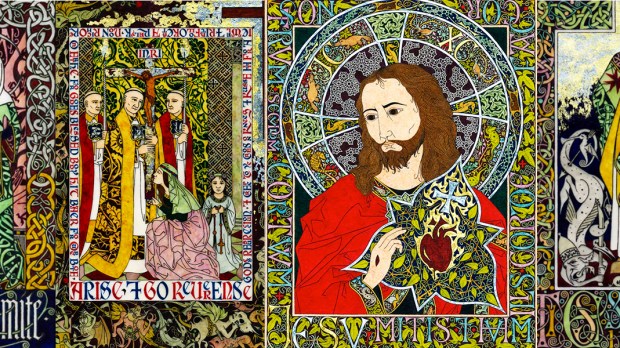As an artist dedicated to the survival and revival of Catholic tradition, my guiding principle has long been the instruction of the Second Nicene Council:
The composition of religious imagery is not the painter’s invention, but is approved by the law and tradition of the Catholic Church. The tradition does not belong to the painter; the art alone is his. True arrangement and disposition belong to the holy fathers who established it.
I believe that the art called Gothic is fully traditional, the last art that did not predicate its originality on a rejection of the past. It is a summary of the iconography of the preceding ages, put into order and expressed more clearly than ever before — the visual equivalent of a high medieval encyclopedia. This is why I make it the basis of my own artwork.
Perhaps paradoxically, because Gothic art is indigenous to the Catholic Church, it can communicate with the art of other traditional cultures especially well. Because its composition is approved by law and tradition, it is not defined by any national or chronological boundary. A farsighted and generous consideration of beautiful forms is in the true spirit of this art.
What is the best way to support Catholic Arts and Letters?
This is especially striking in late Gothic painting of the 14th and 15th centuries. Flemish painters hung Oriental damasks behind their Virgins, and laid Oriental carpets beneath their feet. The Italians copied ornament from art that arrived by trade from Mamluk Egypt. Their saints wear garments bordered with Kufic letters (spelling gibberish) and radiate haloes that resemble Egyptian platters.
This was done, not in a spirit of cultural indifferentism, but in a spirit of giving God what He deserves, the very best we have to offer. Mesopotamian textiles and Mamluk goldsmithery were fitting influences on Catholic art because they were the most precious and beautiful things of their kind that Catholic artists had yet encountered. To eschew them would be something of a cheat on God.
I consider it a sad mischance that the spirit of Gothic art was expelled from Catholic Europe just as the Age of Exploration began. A few treasures of the Aztecs crossed the Atlantic Ocean in time to be admired by Albrecht Dürer, an artist who stood astride the end of the Middle Ages. Most of the treasures arrived too late. Medieval artists never saw the art of the Safavids or of the Khmers. Just imagine what they would have done, had they seen it!
I imagine this, literally. Although I live in the present day and not in medieval times, I embrace the principles of Gothic art, including its same farsighted and generous consideration. In my recent drawings, reproduced below, I attempt to be faithful to Catholic tradition while drawing influence from the art of China, Japan, Egypt, Turkey and Persia. I have also integrated ornament from the early medieval Northumbria and Ireland, and depicted flora and fauna from the entire world.
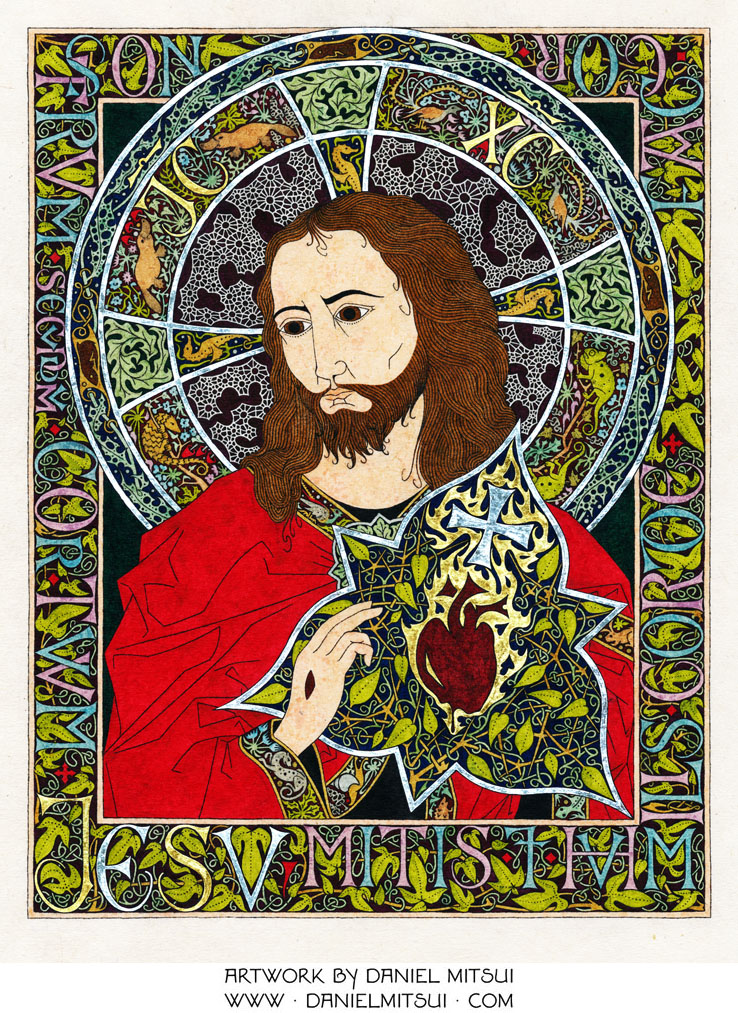
http://www.danielmitsui.com/00_pages/sacred_heart_color.html
My drawing of the Sacred Heart has a composition similar to the 1467 Sanctus Salvator engraving by the Master E.S. But in its coloration, its lack of hatching, and its material (a translucent paper made from kozo fiber) it shows the influence of Japanese woodblock prints as well. Among the animals that appear in Christ’s halo are dogfish, platypodes, lyrebirds, chameleons, and a pangolin.
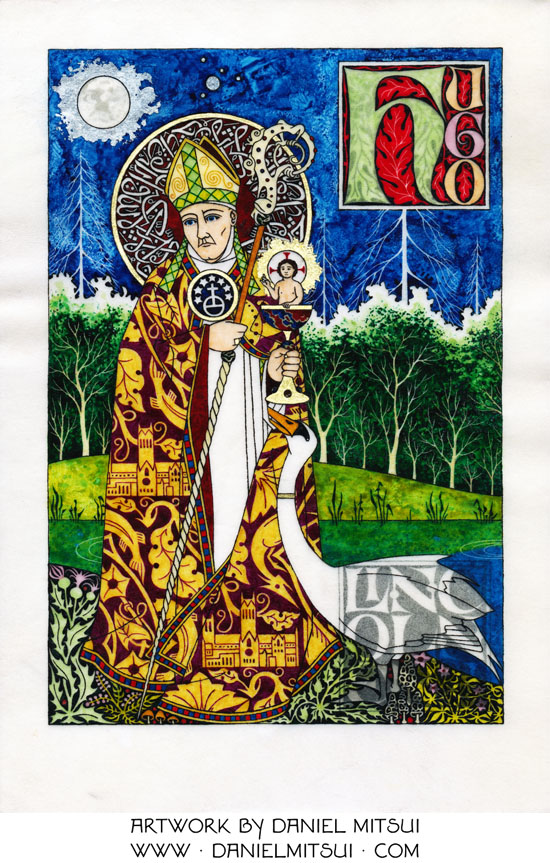
http://www.danielmitsui.com/00_pages/hugh_lincoln.html
St. Hugh was a 12th-century Carthusian hermit who became the Bishop of Lincoln. His halo here contains writing resembles Arabic, but is not; it actually spells the words Amen and Alleluia three times each. The crosier is an adventurous design, with an ivory newt forming the head and a unicorn horn for the shaft and foot.

http://www.danielmitsui.com/00_pages/christopher.html
When drawing the figures of St. Christopher and the Christ Child, I looked to Japanese art, specifically to Utagawa Kuniyoshi’s ukiyo-e series The Sixty-nine Stations of the Kisokaido, which includes an abundance of river scenes and depictions of strong and fearsome men. The composition is basically that of Dieric Bouts’s Pearl of Brabant triptych.
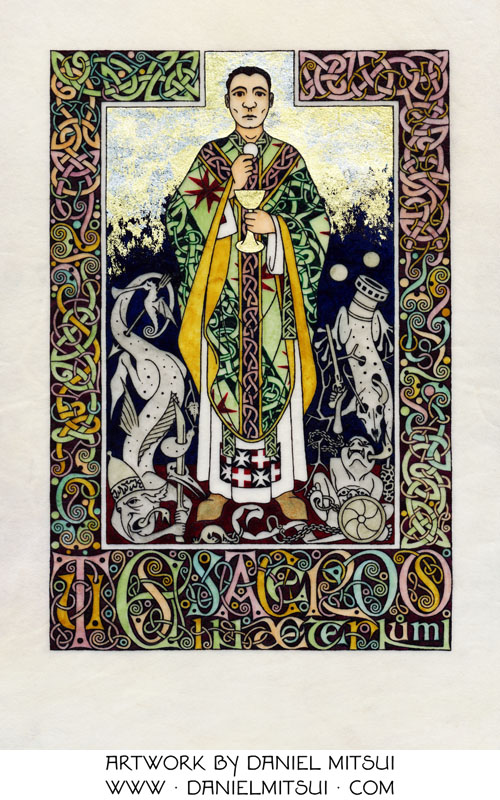
http://www.danielmitsui.com/00_pages/tu_es_sacerdos.html
This depicts a priest holding the host and chalice, while demonic foes flee in terror. I prefer the type of demon that was perfected in the art of Hieronymus Bosch — composed of disparate elements of men, beasts, fish, birds, plants and inanimate objects. The vestments have Northumbro-Irish patterns, as does the decorative border.
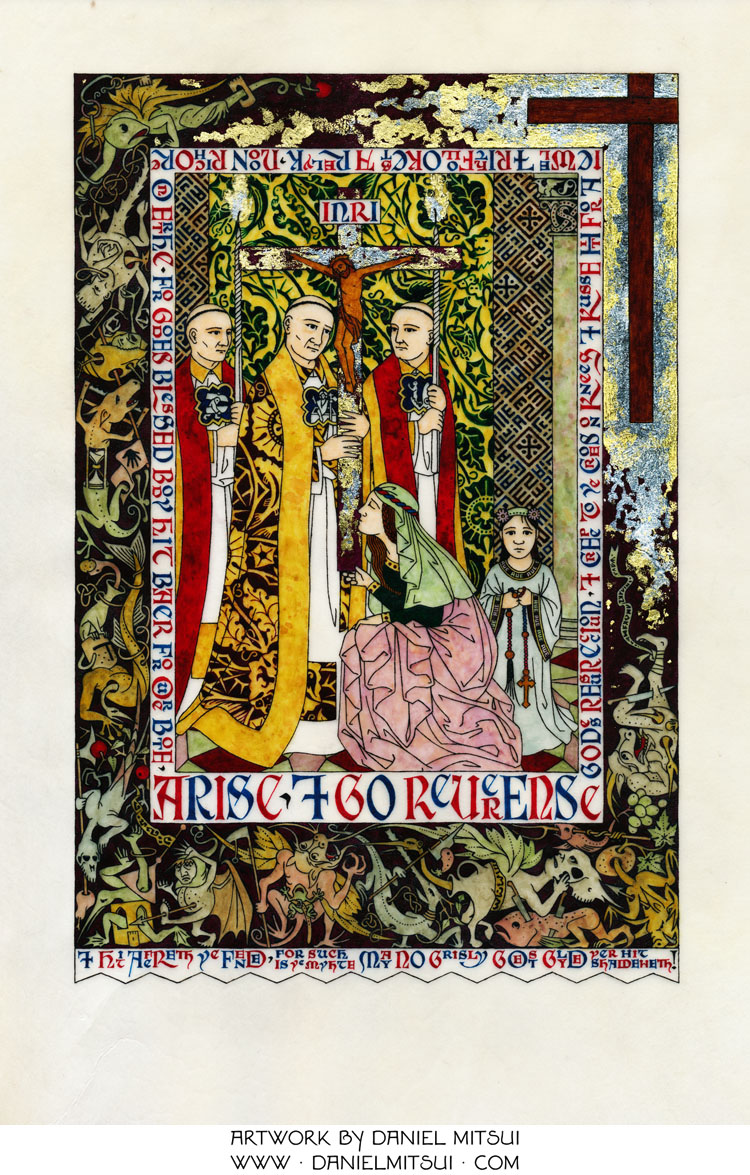
http://www.danielmitsui.com/00_pages/kiss_cross.html
This illustrates a passage from The Vision of Piers Plowman, a Middle English poem. The damask pattern is my own design, and includes Resurrection symbols: the Lion and his three cubs, the Pelican in her piety, and morning glory vines. On the wall, a tile pattern repeatedly spells out the words Amen and Alleluia, interspersed with crosses; this sort of squared lettering is common in Persian architectural ornament.

http://www.danielmitsui.com/00_pages/sarah.html
Northumbro-Irish knotwork, blackletter script, pseudo-Arabic and pseudo-Hebrew lettering, and a damask pattern depicting a peridexion tree are all present in this drawing of the Hospitality of Abraham and the matriarch Sarah laughing at the news that she will bear a child.
Read more: Daniel Mitsui: Innovative Traditionalist
